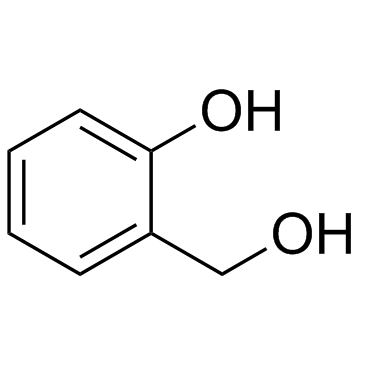Enzymatic synthesis of two salicin analogues by reaction of salicyl alcohol with Bacillus macerans cyclomaltodextrin glucanyltransferase and Leuconostoc mesenteroides B-742CB dextransucrase.
Seung-Heon Yoon, D Bruce Fulton, John F Robyt
Index: Carbohydr. Res. 339(8) , 1517-29, (2004)
Full Text: HTML
Abstract
Beta-Salicin is a naturally occurring glycoside found in the bark of poplar and willow trees. Ancient man used it as an analgesic and antipyretic. It has a D-glucopyranose unit attached by a beta-linkage to the phenolic hydroxyl of salicyl alcohol. Two new salicin analogues have been enzymatically synthesized by transglycosylation reactions: (a) by the reaction of Bacillus macerans cyclomaltodextrin glucanyltransferase with cyclomaltohexaose and salicyl alcohol, followed by reactions with alpha amylase and glucoamylase to give D-glucopyranose attached by an alpha-linkage to the phenolic hydroxyl of salicyl alcohol as the major product, alpha-salicin; and (b) by the reaction of Leuconostoc mesenteroides B-742CB dextransucrase with sucrose and salicyl alcohol, followed by reactions with dextranase and glucoamylase to give alpha-d-glucopyranose attached to the primary alcohol hydroxyl of salicyl alcohol as the major product, alpha-isosalicin.Copyright 2004 Elsevier Ltd.
Related Compounds
| Structure | Name/CAS No. | Molecular Formula | Articles |
|---|---|---|---|
 |
salicyl alcohol
CAS:90-01-7 |
C7H8O2 |
|
Cellular apoptosis and cytotoxicity of phenolic compounds: a...
2005-11-17 [J. Med. Chem. 48 , 7234-42, (2005)] |
|
Functional characterization of two acyltransferases from Pop...
2015-05-01 [Phytochemistry 113 , 149-59, (2015)] |
|
Salicyl alcohol oxidase of the chemical defense secretion of...
2008-07-11 [J. Biol. Chem. 283(28) , 19219-28, (2008)] |
|
Rapid syntheses of benzopyrans from o-OBOC salicylaldehydes ...
2002-10-04 [J. Org. Chem. 67(20) , 6911-5, (2002)] |
|
Precise RNAi-mediated silencing of metabolically active prot...
2012-10-22 [Proc. Biol. Sci. 279(1745) , 4126-34, (2012)] |